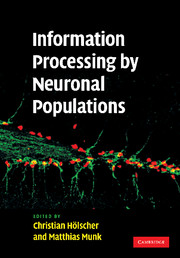Book contents
- Frontmatter
- Contents
- List of contributors
- Part I Introduction
- Part II Organization of neuronal activity in neuronal populations
- Part III Neuronal population information coding and plasticity in specific brain areas
- 7 Functional roles of theta and gamma oscillations in the association and dissociation of neuronal networks in primates and rodents
- 8 Theta rhythm and bidirectional plasticity in the hippocampus
- 9 Distributed population codes in sensory and memory representations of the neocortex
- 10 The role of neuronal populations in auditory cortex for category learning
- 11 The construction of olfactory representations
- Part IV Functional integration of different brain areas in information processing and plasticity
- Part V Disturbances of population activity as the basis of schizophrenia
- Part VI Summary, conclusion, and future targets
- Index
- References
9 - Distributed population codes in sensory and memory representations of the neocortex
Published online by Cambridge University Press: 14 August 2009
- Frontmatter
- Contents
- List of contributors
- Part I Introduction
- Part II Organization of neuronal activity in neuronal populations
- Part III Neuronal population information coding and plasticity in specific brain areas
- 7 Functional roles of theta and gamma oscillations in the association and dissociation of neuronal networks in primates and rodents
- 8 Theta rhythm and bidirectional plasticity in the hippocampus
- 9 Distributed population codes in sensory and memory representations of the neocortex
- 10 The role of neuronal populations in auditory cortex for category learning
- 11 The construction of olfactory representations
- Part IV Functional integration of different brain areas in information processing and plasticity
- Part V Disturbances of population activity as the basis of schizophrenia
- Part VI Summary, conclusion, and future targets
- Index
- References
Summary
Distributed representations are the inevitable consequence of devoting large neuronal circuits to a detailed and adaptive analysis of complex information. The neocortical sheet with its extensive cortico-cortical connectivity is characterized by ubiquitous massive divergence and convergence, sparseness and reciprocity of the vast majority of connections. It therefore appears as an optimized dynamical structure for detailed and adaptive analysis on the one hand and the operation of multiple parallel neuronal processes required for optimizing speed and accuracy of information processing on the other hand. The established concepts of information coding in the cortex are based on tuning functions of many individual neurons thought to express their stimulus specificity in an independent way. A second level of organization is usually attributed to the spatial relations of neurons in topographically organized representations like those in sensory areas and the convergence of neuronal signals carrying information from different modalities into “higher” areas which are more involved in executive functions or the formation of complex memory representations. It has been argued that the collection of neuronal signals from consecutive recording sessions can be used to reconstruct population codes as it has been done with the “population vector” analysis in motor, sensory, and memory areas of the cortex. It is clear that the success of this method relies on fixed neuronal response properties which have been consolidated in cortical circuits over long periods of time such that the spatial pattern and the mixture of neurons contributing to the population response is reasonably stable.
- Type
- Chapter
- Information
- Information Processing by Neuronal Populations , pp. 192 - 223Publisher: Cambridge University PressPrint publication year: 2008

